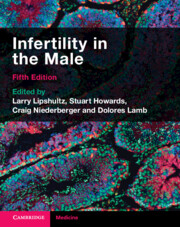Book contents
- Infertility in the Male
- Infertility in the Male
- Copyright page
- Contents
- Contributors
- Foreword
- Abbreviations
- Introduction
- Section 1 Scientific Foundations of Male Infertility
- Section 2 Clinical Evaluation of the Infertile Male
- Chapter 7 Infertility as a Metric of Men’s Health
- Chapter 8 Office Evaluation of the Subfertile Male
- Chapter 9 Evaluation of the Infertile Male’s Partner
- Chapter 10 Imaging the Male Reproductive System
- Chapter 11 Effects of Environmental Chemicals on Male Reproduction
- Chapter 12 Endocrine Causes of Male Infertility – Diagnosis and Treatment
- Chapter 13 Spermatogenesis – Diagnosis of Normal and Abnormal States
- Chapter 14 Inheritance and Male Fertility
- Chapter 15 The Varicocele – Approaches to Diagnosis and Management
- Chapter 16 Infection, Inflammation, and Immunological Causes of Male Infertility
- Section 3 Laboratory Diagnosis of Male Infertility
- Section 4 Treatment of Male Infertility
- Section 5 Health Care Systems and Culture
- Index
- References
Chapter 14 - Inheritance and Male Fertility
from Section 2 - Clinical Evaluation of the Infertile Male
Published online by Cambridge University Press: 08 July 2023
- Infertility in the Male
- Infertility in the Male
- Copyright page
- Contents
- Contributors
- Foreword
- Abbreviations
- Introduction
- Section 1 Scientific Foundations of Male Infertility
- Section 2 Clinical Evaluation of the Infertile Male
- Chapter 7 Infertility as a Metric of Men’s Health
- Chapter 8 Office Evaluation of the Subfertile Male
- Chapter 9 Evaluation of the Infertile Male’s Partner
- Chapter 10 Imaging the Male Reproductive System
- Chapter 11 Effects of Environmental Chemicals on Male Reproduction
- Chapter 12 Endocrine Causes of Male Infertility – Diagnosis and Treatment
- Chapter 13 Spermatogenesis – Diagnosis of Normal and Abnormal States
- Chapter 14 Inheritance and Male Fertility
- Chapter 15 The Varicocele – Approaches to Diagnosis and Management
- Chapter 16 Infection, Inflammation, and Immunological Causes of Male Infertility
- Section 3 Laboratory Diagnosis of Male Infertility
- Section 4 Treatment of Male Infertility
- Section 5 Health Care Systems and Culture
- Index
- References
Summary
Infertility impacts approximately one in six couples attempting to conceive; male factor is at least contributory, if not the sole basis, in 50 percent of these couples [1, 2]. Evaluation of the infertile male starts with the history, followed by the physical examination, and is coupled with semen analysis. The synthesis of this information may suggest inherited conditions (usually autosomal recessive) or de novo abnormalities resulting in an aberrant clinical or spermatozoal phenotype [3, 4]. These may be recognized chromosomal abnormalities, specific gene mutations, or qualitative factors that affect spermatogenesis and fertility potential. Identification of a specific genetic mishap may be informative for the patient and his overall health, for the couple and their therapeutic strategies and results, for the patient’s siblings and first-order relatives, and for the offspring that might be conceived. Although these aberrations may limit natural conception, technical innovations, coupled with the evolution of assisted reproductive technology (ART), may allow previously infertile/sterile couples to parent their own biological children. Helping couples also involves informing them, as best we can, the reasons for the infertility – the etiologies of the sperm defect, the basis for vasal agenesis, and the genetic underpinnings of the abnormally shaped sperm. Although thorough clinical evaluation of the infertile male has always been appropriate, proper genetic analysis and counseling may be equally as important. Male reproductive medicine, surgery, and genetics are inextricably intertwined. This chapter reviews the forms of male infertility that have had an identified genetic basis, summarizes the laboratory tests employed for diagnosis, and briefly discusses more recent salient issues, including concerns regarding the impact of paternal age. Three general subdivisions will be employed: genetic disorders affecting sperm production (in essence, quantitative); genetic disorders affecting sperm function (in essence, qualitative); and genetic disorders affecting sperm transport. This is a paradigm that is unusual but helps to provide a visual way of conceptualizing and compartmentalizing the various conditions discussed. Epigenetics, as it relates to male fertility/infertility, will be discussed in Chapter 6.
- Type
- Chapter
- Information
- Infertility in the Male , pp. 237 - 252Publisher: Cambridge University PressPrint publication year: 2023



